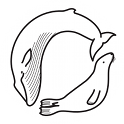


This mapping tool displays published data on the concentration of persistent organic pollutants (POPs) and mercury in cetacean tissues on a global scale. The purpose is to allow researchers to quickly view, and explore visually, trends in the concentrations of commonly monitored contaminants over time.
Each circle shows the number of datasets in the database for the selection chosen, by species, contaminant class, region or decade. For POPs this has been restricted to blubber concentrations (lipid weight) in males only (to avoid the effect of contaminant offloading in females). For mercury all data from concentrations in liver (dry weight) have been combined.
If the option to select all the data for a given region is chosen, then the plot in the bottom right shows the median and range of the data by each decade.
If the user then clicks on the circle, the map zooms to that region to show where within the area the individual records were obtained. At the lowest level the user can then see the median concentrations and the number of datapoints for that area which were then combined into the figure at the bottom left. If there is insufficient data for the script to calculate a trend (with a geometric mean and standard deviations) for a species, region or decade, then the plot reverts to a bubble plot showing the individual data with the size of the points being related to the number of animals contributing to the dataset. Unfortunately, in most cases the raw data are not published so it has not been possible to delve deeper into the uncertainty and variability in some of the datasets.
If the user then choses a certain decade, the plot in the bottom right changes to a bubble plot. The x axis is then the particular years within that decade for which data were available. If there are no data for a given year a red error message will appear.
At the lowest level, when the circles convert to blue pointers for an individual dataset the user can click on this and see the median values and the number of samples contributing to that dataset.